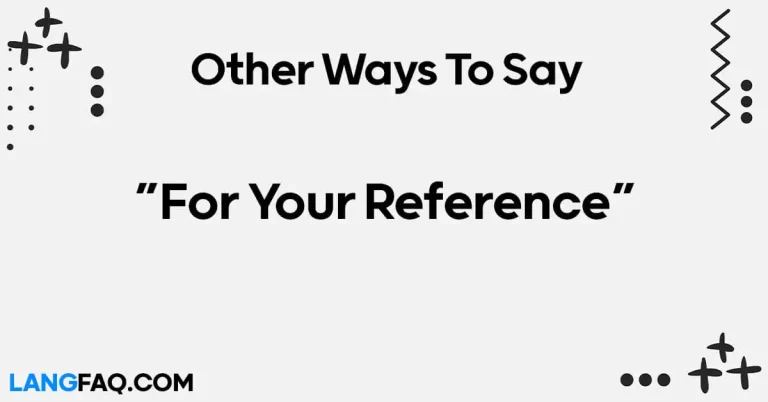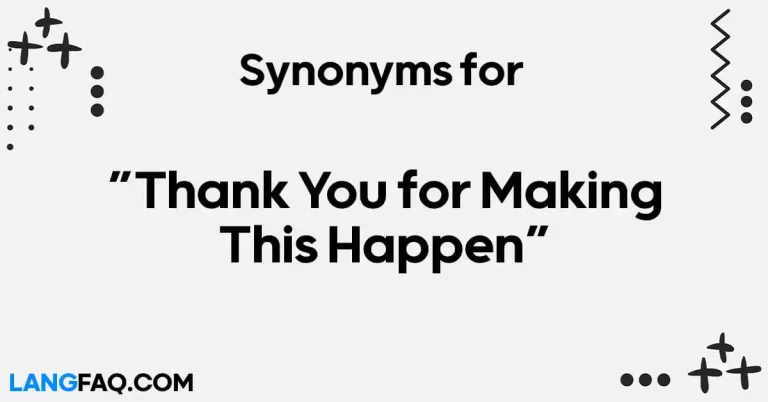In the realm of communication, expressing detachment or disinterest can be delicate. This article delves into 12 alternative ways to say “That’s Not My Problem,” offering a nuanced understanding for diverse scenarios. Effective communication is essential in personal and professional spheres, and mastering these expressions adds finesse to your language toolkit.
12 Other Ways to Say “That’s Not My Problem”
Here are 12 alternative ways to say “That’s Not My Problem”:
- It’s outside my purview.
- I’m not responsible for that matter.
- This doesn’t fall under my jurisdiction.
- It’s not within my scope of duty.
- That issue isn’t on my plate.
- Handling this isn’t part of my role.
- It’s beyond the scope of my responsibilities.
- I’m not tasked with dealing with that.
- This falls outside my area of expertise.
- Dealing with this isn’t within my remit.
- I don’t have a role in addressing that concern.
- It’s someone else’s responsibility to handle that.
Here’s a table with meanings and examples for the 12 alternative ways to say “That’s Not My Problem”:
| Expression | Meaning | Example |
|---|---|---|
| It’s outside my purview. | Beyond the range of my responsibilities. | “I’m sorry, but handling customer complaints is outside my purview.” |
| I’m not responsible for that matter. | Not accountable for the specific issue. | “I appreciate your concern, but I’m not responsible for office supplies; you should ask the admin team.” |
| This doesn’t fall under my jurisdiction. | Not within the area I oversee. | “The legal aspects of the project don’t fall under my jurisdiction; you should consult our legal team.” |
| It’s not within my scope of duty. | Outside the range of tasks I’m assigned. | “Fixing technical issues is not within my scope of duty; you should contact our IT department.” |
| That issue isn’t on my plate. | I’m not dealing with that particular matter. | “I appreciate your concern, but handling financial matters isn’t on my plate; talk to the finance team.” |
| Handling this isn’t part of my role. | Not included in the responsibilities of my position. | “As a receptionist, handling client negotiations isn’t part of my role; please contact the sales team.” |
| It’s beyond the scope of my responsibilities. | Outside the range of tasks assigned to me. | “Handling international affairs is beyond the scope of my responsibilities as a local coordinator.” |
| I’m not tasked with dealing with that. | It’s not a task assigned to me. | “I’m not tasked with dealing with customer complaints; please reach out to our customer service team.” |
| This falls outside my area of expertise. | Beyond my specialized knowledge. | “As a biologist, solving complex mathematical problems falls outside my area of expertise.” |
| Dealing with this isn’t within my remit. | Not within the scope of my responsibilities. | “Creating marketing strategies isn’t within my remit as an HR manager; you should ask the marketing team.” |
| I don’t have a role in addressing that concern. | Not designated to handle that issue. | “I don’t have a role in addressing supply chain issues; please contact our logistics department.” |
| It’s someone else’s responsibility to handle that. | Another person or team is accountable for this. | “Handling IT infrastructure is someone else’s responsibility; you should contact our IT department.” |
These diverse expressions provide a range of diplomatic ways to convey “That’s Not My Problem.” Whether it’s gracefully setting boundaries, asserting one’s role, or redirecting responsibilities, these alternatives offer nuanced approaches suitable for various situations. Mastering these phrases allows for effective communication while maintaining professionalism and respect.
Is It Correct to Say “That’s Not My Problem”?
In the realm of verbalizing disinterest or non-involvement, the phrase “That’s Not My Problem” stands out as a straightforward and commonly used expression. However, its appropriateness hinges on the context, relationship dynamics, and the tone in which it’s delivered.
Usage Insights
In casual or informal settings, employing “That’s Not My Problem” might be acceptable, especially among friends or close colleagues. It can convey a sense of honesty and straightforwardness. Nevertheless, in more formal or professional situations, a more tactful approach is often recommended to maintain a positive atmosphere and uphold professional standards.
Pros of Using “That’s Not My Problem”
- Clarity: The phrase is clear and direct, leaving no room for ambiguity.
- Straightforwardness: It communicates non-involvement without beating around the bush.
- Honesty: It reflects honesty about one’s responsibilities and boundaries.
Cons and Considerations
Perceived Rudeness: In some situations, especially in professional contexts, the phrase might be perceived as blunt or dismissive. Impact on Relationships: Depending on the relationship dynamics, using this phrase without tact could strain relationships or create tension. Alternative Expressions: There are numerous alternative ways to convey non-involvement with more finesse, which might be more appropriate in certain situations.
When and Where to Use
Among Friends: In casual, familiar settings, friends might use this phrase playfully without causing offense.
- Example: “Hey, can you help me move this weekend?” – “Sorry, buddy, that’s not my problem!”
At Work: In a professional setting, especially when communicating with superiors, colleagues, or clients, consider more diplomatic alternatives.
- Example: “Can you take on this additional task?” – “I appreciate the request, but my current workload doesn’t allow me to take on extra tasks.”
Grammar and Usage Rules
- When using the phrase, ensure that the tone matches the context to avoid coming across as rude.
- Use appropriate body language and facial expressions to convey the intended meaning without causing offense.
Exceptions and Variations
Consider variations like “I’m afraid I can’t assist with that,” or “I’m not equipped to handle this matter,” depending on the formality of the situation.
Tips for Effective Communication
- Combine Honesty with Tact: If using “That’s Not My Problem,” pair it with a polite explanation to soften the impact.
- Consider the Setting: Gauge the formality of the situation and adjust your language accordingly.
- Offer Alternatives: If possible, suggest alternative solutions or direct the person to someone who can help.
Professional Mail Example With “That’s Not My Problem”
Subject: Clarification on Assigned Tasks
Dear [Recipient’s Name],
I trust this email finds you well. I wanted to address a recent inquiry you had regarding the additional responsibilities related to project coordination.
Upon careful review of my current workload and responsibilities, I regret to inform you that overseeing project timelines is not within my remit. As you may know, my primary focus is on [mention your primary responsibilities].
I understand the urgency of the matter and share your commitment to the success of our projects. However, I believe redirecting this concern to the project manager would be a more efficient way to ensure accurate oversight and a timely resolution.
I appreciate your understanding of the situation, and I’m confident that the project manager will be able to address this matter promptly and effectively.
Thank you for your cooperation.
Best regards,
[Your Full Name] [Your Position] [Your Contact Information]
Empathetic Responses: Understanding and Compassion
In the realm of effective communication, expressions of empathy can significantly impact how we navigate sensitive situations. Utilizing phrases that convey understanding and compassion, such as “It’s outside my purview,” is crucial when addressing concerns without taking ownership.
When to Use: Empathetic responses are particularly valuable in scenarios where acknowledging the issue is essential, but assuming responsibility is not appropriate.
Example Sentence: “I understand this is a challenging situation, but handling budgetary concerns is outside my purview as the creative director. Let’s involve the finance team for a more effective resolution.”
Variations:
- In a Mentor-Mentee Context: “I see you’re facing difficulties, but solving complex design issues isn’t part of your current mentorship tasks. Let’s discuss how you can approach this collaboratively.”
Email Sample:
Subject: Acknowledging the Challenge Dear [Recipient],
I appreciate your reaching out about the recent issues with project timelines. However, managing project schedules is outside my purview as the design lead. Let’s coordinate with the project management team to address this effectively.
Best regards,
[Your Name]
Polite Disengagement: Politely Declining Responsibility
Maintaining cordiality while declining responsibility is an art that professionals often need to master. Phrases like “I’m not responsible for that matter” allow for graceful disengagement without causing offense.
When to Use: Polite disengagement is suitable when acknowledging the concern but asserting that it falls outside your specific responsibilities.
Example Sentence: “I appreciate your concern regarding the team dynamics, but I’m not responsible for that matter. You might want to discuss this with the team lead for a more targeted resolution.”
Variations:
- In a Colleague Context: “I understand the urgency, but handling client communications isn’t my responsibility. I recommend looping in the communications team for a more immediate response.”
Email Sample:
Subject: Clarification on Responsibility Dear [Recipient],
Thank you for bringing up the issue with inventory management. However, I’m not responsible for that matter. I suggest getting in touch with the operations team for a quicker resolution.
Kind regards,
[Your Name]
Polite Disengagement: Deferring Without Offense
In some situations, it’s not about refusing responsibility but rather deferring it gracefully. Phrases like “This doesn’t fall under my jurisdiction” allow for a nuanced approach in maintaining professional relationships.
When to Use: Deferring without offense is appropriate when clarifying that the issue is not within your purview but requires attention from another department or individual.
Example Sentence: “I understand the urgency of the matter, but handling legal aspects of the contract doesn’t fall under my jurisdiction. I recommend consulting our legal team for guidance.”
Variations:
- In a Managerial Context: “I appreciate your concern, but addressing employee grievances doesn’t fall under my jurisdiction. I suggest reaching out to HR for a more comprehensive resolution.”
Email Sample:
Subject: Redirecting for Legal Guidance Dear [Recipient],
Thank you for your query regarding contract terms. Handling legal aspects doesn’t fall under my jurisdiction. I recommend consulting our legal team for accurate guidance.
Sincerely,
[Your Name]
Direct Communication: Clear-cut Statements
When the situation demands clarity without ambiguity, direct communication becomes essential. Phrases like “It’s not within my scope of duty” allow for straightforwardness while maintaining professionalism.
When to Use: Clear-cut statements are necessary when precision is crucial, especially in professional settings where avoiding misunderstandings is paramount.
Example Sentence: “I want to be clear that managing software updates is not within my scope of duty. For IT-related concerns, please liaise directly with our IT department for immediate assistance.”
Variations:
- In a Project Management Context: “I appreciate your input, but overseeing project timelines is not within my scope of duty. I recommend discussing this with the project manager for a more tailored solution.”
Email Sample:
Subject: Clarification on Responsibilities Dear [Recipient],
Thank you for your inquiry. I want to clarify that overseeing data security is not within my scope of duty. Please contact our IT department for more information.
Best regards,
[Your Name]
Direct Communication: Honest Assertion
Honesty is the foundation of effective communication, and asserting your position with transparency is crucial. Phrases like “I’m not tasked with dealing with that” allow for honest communication without unnecessary complications.
When to Use: Honest assertion is appropriate when clearly communicating your non-involvement is essential to prevent misunderstandings.
Example Sentence: “I want to be upfront about this – managing client relationships is not a task I’m tasked with. For client-related matters, please connect directly with our account management team for personalized assistance.”
Variations:
- In a Team Setting: “I appreciate your bringing this to my attention, but handling internal conflicts is not a task I’m tasked with. I recommend discussing this with our HR department for a more effective resolution.”
Email Sample:
Subject: Clarification on Tasks Dear [Recipient],
Thank you for reaching out. I’m not tasked with dealing with client negotiations. For matters concerning clients, I suggest coordinating with our account management team for a more personalized approach.
Sincerely,
[Your Name]
Casual Expressions: Easygoing Responses
In more relaxed situations, opting for easygoing responses can diffuse tension and maintain a positive atmosphere. Phrases like “That issue isn’t on my plate” convey a laid-back tone while asserting non-involvement.
When to Use: Easygoing responses are suitable for informal settings where a more casual tone is acceptable and can help keep the mood light.
Example Sentence: “I get where you’re coming from, but honestly, managing office supplies isn’t on my plate. Let’s have a laugh about it and maybe ask the admin team for some help?”
Variations:
- Among Peers: “I hear you, but dealing with office politics isn’t on my plate. Let’s grab a coffee and unwind, shall we?”
Email Sample:
Subject: Light-hearted Clarification Hey [Recipient],
I caught your message about the coffee machine glitch. Honestly, fixing gadgets isn’t on my plate. Let’s share a laugh and loop in our tech-savvy colleagues for a quick fix.
Cheers,
[Your Name]
Casual Expressions: Informal Denial
In informal situations, using more laid-back language can effectively communicate non-involvement without sounding dismissive. Phrases like “Handling this isn’t part of my role” keep the tone light while asserting boundaries.
When to Use: Informal denial is suitable for casual interactions where maintaining a friendly atmosphere is key.
Example Sentence: “I hear you, but managing last-minute requests isn’t part of my role. Let’s chat with the project coordinator; they might be able to help us out.”
Variations:
- Among Friends: “I get where you’re coming from, but dealing with drama isn’t part of my role. Let’s catch up over lunch instead?”
Email Sample:
Subject: Clarification on Role Hey [Recipient],
Thanks for reaching out about the office party planning. Honestly, event coordination isn’t part of my role. Let’s loop in the events team for some expert advice.
Cheers,
[Your Name]
Professional Settings: Businesslike Refusal
Maintaining professionalism while refusing responsibility is crucial in a business context. Phrases like “It’s beyond the scope of my responsibilities” convey a businesslike approach, ensuring clear communication.
When to Use: Businesslike refusal is necessary in formal settings where maintaining a professional demeanor is paramount.
Example Sentence: “I appreciate your bringing this to my attention, but managing client complaints is beyond the scope of my responsibilities. I suggest contacting our customer service team for a more detailed resolution.”
Variations:
- In a Leadership Role: “I understand the urgency, but overseeing daily operations is beyond the scope of my responsibilities as the CEO. Let’s involve the operations team for a comprehensive solution.”
Email Sample:
Subject: Redirecting for Expert Assistance Dear [Recipient],
Thank you for reaching out regarding the recent customer complaint. Managing these concerns is beyond the scope of my responsibilities. I recommend reaching out to our customer service team for immediate assistance.
Best regards,
[Your Name]
Professional Settings: Workplace Diplomacy
Navigating workplace dynamics requires finesse and diplomacy. Phrases like “Workplace Diplomacy” can effectively communicate non-involvement while ensuring a harmonious work environment.
When to Use: Workplace diplomacy is crucial when addressing matters that may involve different team members or departments.
Example Sentence: “I understand the importance of resolving this issue, but handling inter-departmental conflicts is beyond my scope. Let’s involve HR to ensure a smooth and diplomatic resolution.”
Variations:
- In a Cross-Functional Team: “I appreciate your concern, but overseeing project timelines is beyond my scope. I recommend coordinating with the project manager for a more streamlined resolution.”
Email Sample:
Subject: Diplomatic Approach to Resolution Dear [Recipient],
Thank you for raising the concern about team collaboration. Handling inter-departmental matters is beyond my scope, so I suggest involving HR to ensure a diplomatic resolution.
Sincerely,
[Your Name]
Delegating Tasks: Efficient Delegation
When an issue is not within your purview, efficient delegation is an excellent alternative. Phrases like “I appreciate your concern, but handling this isn’t within my remit” allow for the seamless transfer of responsibility.
When to Use: Efficient delegation is suitable when the task can be effectively handled by another individual or department.
Example Sentence: “I see the urgency, but overseeing inventory management isn’t within my remit. Let’s delegate this to the operations team for a quicker and more efficient resolution.”
Variations:
- In a Collaborative Environment: “I appreciate your input, but handling project timelines isn’t within my remit. I recommend delegating this to the project manager for a more targeted solution.”
Email Sample:
Subject: Delegating for Timely Resolution Dear [Recipient],
Thanks for bringing up the issue with supply chain management. Handling these logistics isn’t within my remit, so I suggest delegating this to the operations team for a more efficient resolution.
Best regards,
[Your Name]
Delegating Tasks: Redirecting Responsibility
Skillfully redirecting responsibility is an art that ensures a smoother resolution without burdening yourself unnecessarily. Phrases like “Redirecting Responsibility” can guide individuals toward the right channels.
When to Use: Redirecting responsibility is appropriate when another person or department is better equipped to handle the specific concern.
Example Sentence: “I appreciate your reaching out, but managing IT infrastructure isn’t my forte. Let’s redirect this to our IT department for a more efficient and targeted solution.”
Variations:
- In a Consultative Setting: “I understand your concerns, but overseeing legal matters isn’t my expertise. I suggest redirecting this to our legal team for accurate guidance.”
Email Sample:
Subject: Redirecting for Expertise Dear [Recipient],
Thank you for bringing up the issue with technical glitches. Redirecting responsibility, I recommend involving our IT department for a more efficient resolution.
Sincerely,
[Your Name]
Personal Boundaries: Setting Personal Limits
Asserting personal limits is crucial for maintaining a healthy work-life balance. Phrases like “Setting Personal Limits” can effectively communicate your boundaries while emphasizing the importance of respecting individual capacities.
When to Use: Setting personal limits is appropriate in situations where maintaining balance and well-being is paramount.
Example Sentence: “I hear your concerns, but managing additional projects isn’t something I can take on right now. Setting personal limits is crucial for ensuring the quality of my work. Let’s explore other options together.”
Variations:
- In a Team Context: “I appreciate your trust in my abilities, but taking on extra tasks isn’t conducive to setting personal limits. Let’s discuss how we can distribute the workload more evenly.”
Email Sample:
Subject: Clarification on Workload Dear [Recipient],
Thank you for considering me for the additional project. However, setting personal limits is crucial for maintaining the quality of my work. Let’s explore alternative options together.
Best regards,
[Your Name]
FAQs
What’s the importance of using alternative phrases for “That’s Not My Problem”? Understanding alternative expressions fosters better communication, allowing you to convey disinterest or non-involvement without causing tension.
Can casual expressions be used in professional settings? While it depends on the workplace culture, it’s generally advisable to maintain professionalism in business settings.
How do I set personal boundaries without coming across as rude? Assert your limits with empathy and honesty. Clearly communicate your boundaries while acknowledging others’ perspectives.
Is delegation always a suitable option? Delegation works well when the task can be effectively handled by someone else. Assess the situation before opting for delegation.
Why is positive language important in problem-solving communication? Positive language fosters a collaborative atmosphere, encouraging others to actively engage in finding solutions.
How can I gracefully maintain personal boundaries in personal relationships? Communicate your boundaries with love and respect. Emphasize the importance of mutual understanding and support.
Conclusion
Mastering the art of conveying “That’s Not My Problem” is an essential aspect of effective communication. By exploring these 12 alternatives and understanding the nuances of each, you empower yourself to navigate various scenarios with finesse and tact.







